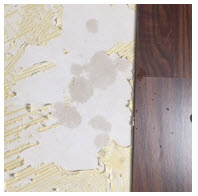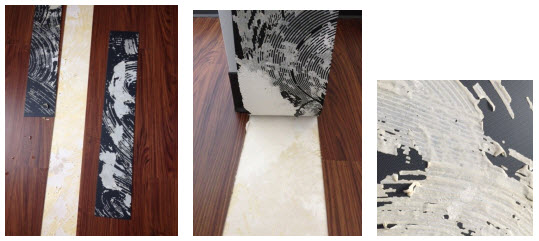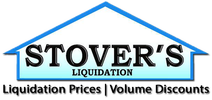Resilient Flooring and Dealing with Gypsum Underlayments
Gypsum underlayments are becoming more and more popular with contractors and are presenting more and more problems in the flooring industry.
Gypsum Floor Underlayments are non-structural, poured gypsum floor underlayments that supply fire resistance and sound control while providing a durable, flat surface for finished floor coverings that are light in weight, inexpensive and becoming more and more popular in apartments, hotels and multi-family housing. A 1.5-inch slab of gypsum concrete weighs 13 pounds per square foot versus 18 pounds per square foot for regular concrete. Even though gypsum weighs less, it still can have the same compressive strength as concrete. The brand name GypCrete, a Maxxon Corporation product, has become the general use word for all gypsum toppings by construction people. The two biggest Gypsum Toppings suppliers that I hear of are Maxxon and Hacker Industries who each has several Gypsum topping products.
INSTALLATION - Before, during, and after installation of a Gypsum floor underlayment, the building interior shall be enclosed and maintained at a temperature above 50°F until structure and subfloor temperatures are stabilized. Proper ventilation is critical. Provide continuous ventilation and adequate heat to remove moisture rapidly from the area until the underlayment is dry. Provide mechanical ventilation if necessary.
DRYING CONDITIONS The drying time for gypsum floor underlayments is dependent upon several variables. Ventilation, weather, humidity, the amount of water in the building and the underlayment at the time of installation, and the thickness of the underlayment will all affect the drying time of the gypsum floor underlayment. And, as you know in new construction we just do not get these conditions.
Before, during and after installation of gypsum floor underlayments, the building interior must be properly ventilated and heated (minimum 50°F). Under these conditions, a Gypsum topping installed at 3/4″ thick should usually dry in about 7-10 days. In a building without all of these conditions present, the drying time can increase. Low temperatures, certain sands, poor ventilation and high humidity can lengthen the drying time. Weather permitting; windows should be kept open until the gypsum floor underlayment is completely dry.
If not, mechanical ventilation and heat is necessary. Regardless of temperature, and/or weather conditions, the air must be exchanged daily in all areas until the gypsum floor underlayment is completely dry.
Do not install floor coverings until the gypsum floor underlayment is completely dry. The recommended procedure to test for dryness is to use a moisture meter with a gypsum scale.
The recommended moisture meters: Delmhorst BD-2100 Delmhorst G-79
The acceptable moisture content of the Gypsum when using these meters should be 5% or less. The issue here is that flooring manufacturers do not recognize these tests as acceptable moisture tests for vinyl flooring.
ASTM F2170 the Insitu RH Probe Test is acceptable test method for Gypsum toppings. The issue with this test method is that the Gypsum Topping is usually applied at such a thin layer and that this test cannot be performed properly to test the moisture content of the Gypsum topping. The minimum thickness of a Gypsum topping applied to a wood subfloor is 3/4″ and 1/2″ over a concrete subfloor.
Unlike concrete subfloors, Gypsum toppings must be sealed to prevent reduction of the working times of the flooring adhesives. With concrete, adding a sealer can become a bond breaker with adhesives and patching compounds. But with Gypsum toppings, the finished surface must be sealed. The Gypsum topping contractor is supposed to apply a TopCoat/Sealer to the Gypsum after it dries to enhance and strengthen the bond between the Gypsum Topping and the adhesive and also keep the Gypsum from dusting up. The Gypsum surface to receive the Top Coat/Sealer must be free of mud, oil, grease, and other contaminants. Make sure the surface is completely dry so adhesives can achieve maximum bond. Surface porosity of the gypsum floor underlayment is a major factor in the drying rate of adhesives. This porosity factor will greatly reduce the open time of the flooring adhesive and can reduce the working of an adhesive in half. An LVT Adhesive with a 2 hour working time over concrete may only have a 1 hour working time over an improperly sealed Gypsum topping.
The issue is that the Top Coat/Sealer applied to the Gypsum topping right after it has dried, this Top Coat/Sealer has been walked/trafficked off by construction traffic resulting in a very porous surface which will reduce the working time of the adhesive.
Before proceeding with the installation of the resilient flooring, check the Gypsum topping for porosity. Sprinkle some water on the Gypsum topping, is the Gypsum topping is sucking away the water, the surface of the Gypsum is not sealed properly and will rob the adhesive of its working time. This will require an additional coat of primer/sealer. When the water is beading up, the Gypsum topping is sealed properly and the adhesive will have its recommended working time.

Water being absorbed by the porosity of the Gypsum
Perform a bond test of the flooring to the Gypsum to ensure you have adequate bonding to the gypsum underlayment. Using the flooring material and recommended adhesives, install 3 foot by 3 foot piece of flooring spaced approximately 50 feet apart throughout the area. Select areas next to walls, columns or other light traffic areas. Tape edges of panels to prevent edge drying of adhesive. If the flooring is securely bonded after a period of 72 hours, you may conclude that the subfloor surface is sufficiently clean of foreign material for satisfactory installation of the resilient flooring. The adhesive should be sticking to the substrate and should not be removing a fine layer of the Gypsum topping as pictured below.

Many flooring and patching manufactures make a latex primer for reducing porosity of a subfloor. Several that come to mind are Armstrong S-185, DriTac DriBloc, Henry 336 and Mapei Primer L.

